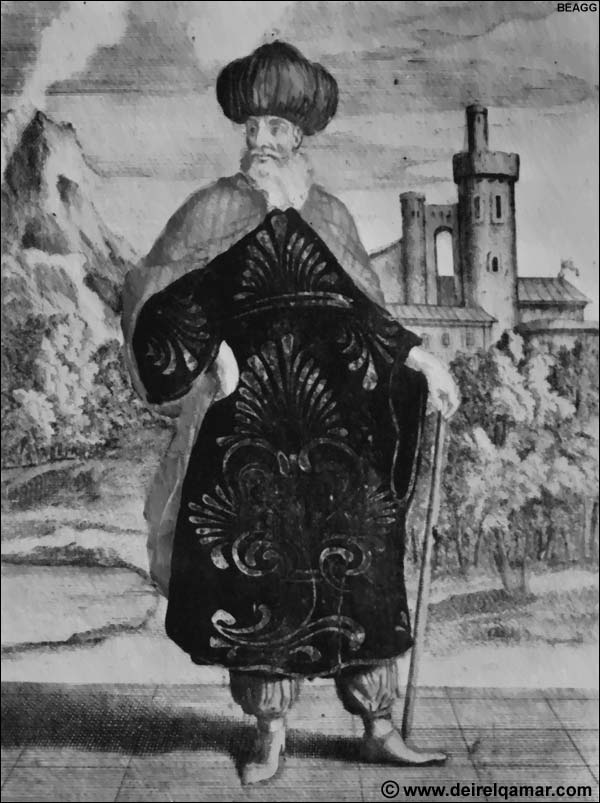
Population Movements to Keserwan
During the Ottoman rule, and specifically during the reign of Prince Assaf el Turkmani in Keserwan, a lot of Lebanese migrated towards Jounieh. The Shiites came from Baalebck as well as the Bekaa Sunnites, Druzes from Mount Lebanon and Christians from Tripoli province. Prince Mansour Al Assafi succeeded to Assaf el Turkmani and people were still flowing to Keserwan due to the safety and security that the area was witnessing in the 16th century.
Here are some of the known population movements in 1545, as documented by Patriarch Estephan El Douaihy and Sheikh Chiban el Khazen.
"Jaj residents moved to Keserwan, Gemayel family to Bekfaya, the Kmeid family to Ghazir and Chidiac Sarkis el Khazen to Bouar. Cheikh Chidiac didn't settle for long in Bouar and moved to Antelias; his son Ibrahim married a girl from the Gemayel family and had several children, with the eldest called Khazen (Abou Nader). Cheikh Sarkis never left Ballouneh, while his eldest son went to Ghosta, another to Ajaltoun and the third son stayed in Ballouneh.
The Maans and The Khazens
In 1585, Egypt's Ibrahim Bacha led a campaign in the Chouf area against Maanite Prince Korkomaz to impose the Ottoman authority. Later on, the prince died from poisoning, leaving behind him two young kids Prince Fakhreddine the Second and Prince Younes. Sit Nassab, widow of Prince Korkomaz, rescued the children and put them away from danger. There are several conflicting stories based on various historical references from Lebanon and abroad on the fate of the princes. Prince Chayban el Khazen states that Sit Nassab took both kids to the house of Cheikh Ibrahim son of Chidiac Sarkis el Khazen in Ballouneh where they spent around 7 years in his custody and were well treated and given the needed education, before both princes returned to the Chouf and Prince Fakhreddine took over the reign and asked Cheikh Ibrahim el Khazen and his brother Cheikh Rabah to be his advisors. After Cheikh Ibrahim passed away, his son Cheikh Abou Nader el Khazen assumed his position of Moudabber for the Prince.
In Addition to support the claim that Fakhr el Dine was raised by the Khazen's, Dr. Farha adds in hiw 2005 research at Harvard University that:
"Fakhr ed-Din inaugurated a policy allowing Maronites and other Christian groups to build Churches and toll bells. Some have attributed this Druze-Christian amity to Fakhr ed-Din’s being raised by Abu Saqr al-Khazen in Kisirwan. (Rene Ristelhuber, Traditions Francaises au Liban, Paris: Alcan. p.132. Hammer-Purgstall, Geschichte des Osmanischen Reiches, Graz. 1963, vol. IX, p.225. Despite these multiple sources, Youssef al-Choueiri contests that story is a fabrication not appear in the early biographers of Fakhr al-Din. i.e. before its invention by Shaikh Shayban al-Khazin (d.1850). Choueiri does not mention the Florentine Mariti who describes the formative years of Fakhreddin’s childhood and education with the Khazins in great detail. It was this early connection which according to Mariti led Fakhr e-Din to subsequently call Abu Saqr his “father” and his lasting indebtedness towards the Khazins which in turn lead to Abu Safi al-Khazin and Abu Nadir al-Khazin being tapped by Fakhr ed-Din to accompany and advise him during his exile in Tuscany from 1613-1618. Abu Nadir came to serve as Fakhr ed-Din’s prime minister and right-hand man during over three decades."
To smmarize what is sure is that the Khazens assisted and advised politically Prince Fakhreddine the Second in the best way possible, and allocated a sum of money from the Keserwan district to his service. One of the historical documents from Harvard of Italian Giovanni Mariti's account of Fakhreddine in an 18th century German translation states that "Fakhreddine inaugurated a policy allowing Maronites and other Christian groups to build Churches and toll bells, and that some have attributed this Druze-Christian amity to Fakhreddine being raised by Abu Saqr el Khazen in Keserwan".